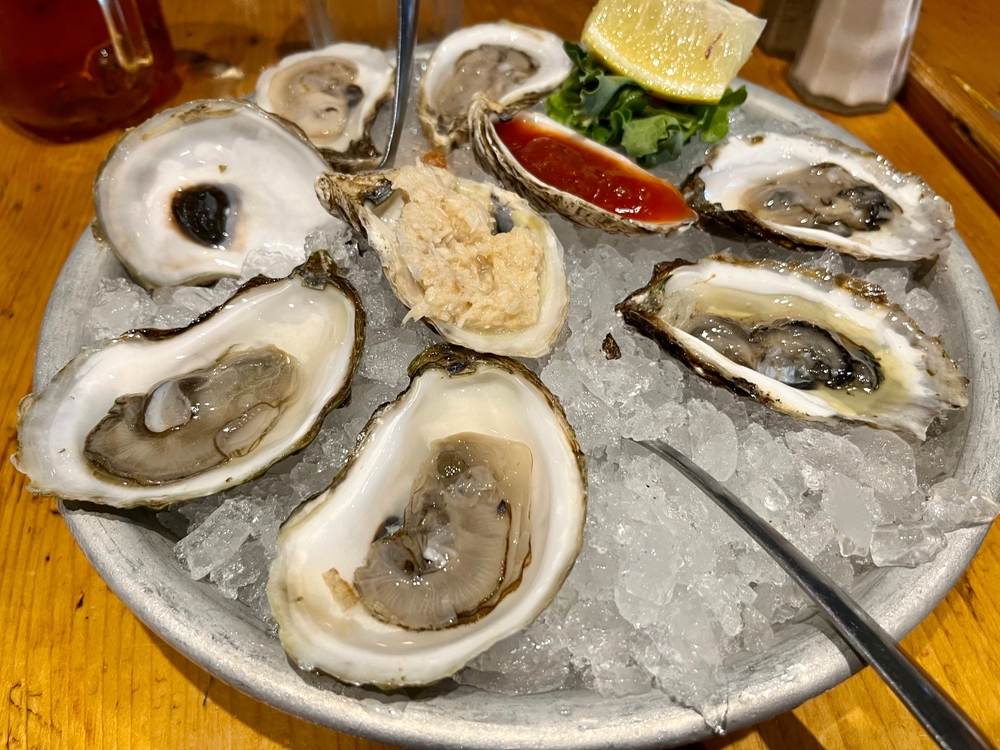Humans have been eating oysters for thousands and thousands of years. For many, a warm summer evening wouldn’t be complete without a plate of oysters and a glass of champagne, and due to their reported aphrodisiac qualities, they are a first-date choice of many.
Maybe oysters are one of your favorite foods, but did you know that oysters may still be alive, even as you’re eating them?
Why Are Oysters Alive When We Eat Them?

When a plate of oysters arrives at your table they are either raw or were just freshly killed. There are a few reasons for this:
Food safety. Oysters are “filter feeders”, meaning they absorb everything that is in the water around them. Because of this, they can soak up bacteria, viruses, and other toxic chemicals that leach into our waterways [1].
This, of course, is a concern for anyone who is going to eat them, since when you eat the oyster, you are also eating any bacteria that is found within it. The primary concern with respect to shellfish is a bacteria called Vibrio Vulnificus. These bacteria typically live in coastal waters (coincidentally, where oysters are also found) and thrive particularly during the warmer months of the year [2]. You can become infected with Vibrio Vulnificus by swimming in warm brackish water (that is a mixture of fresh and saltwater where a river meets the sea) with an open wound, or by eating raw oysters [2]. Keeping the oyster alive as long as possible reduces the risk of bacterial contamination.
Taste and quality. Any time you eat shellfish, you want it to be as fresh as possible. When you purchase oysters, they are typically kept alive on ice until it is time to prepare them. Before serving, they are shucked. This involves separating the oyster’s abductor muscle from the shell, which either kills it or renders it immobile. This may sound cruel, but consider that the oyster is a very primitive creature, and has no brain. Because of this, the oyster likely feels no pain at all [3].
Keeping the oyster alive as long as possible before consuming it ensures its freshness and maintains the right flavor profile, texture, and nutrient density [4].
Read More: Man is Eating Raw Chicken Daily to ‘See What Happens’
Is Eating Oysters Dangerous?

While Vibrio Vulnificus bacteria may sound scary, infection with this bacteria is actually fairly rare. Considering that it causes about one hundred deaths in the United States every year, while the salmonella bacteria found on raw produce kills about 450, your time would be better spent worrying about the lettuce you just picked up from the grocery store than the oysters you ate last week [5,6].
Before oysters reach your table, they have been given a health certification to ensure that they are clean. Purification involves placing them under clean, running water for twelve hours or more, which gets rid of any potentially harmful contaminants [1].
Read More: Why You Should Consider Eating Raw Garlic Daily
The Health Benefits of Oysters

Oysters are low in calories but offer much in the way of nutrient value:
- They are a source of omega-3 fatty acids, which help to fight inflammation in your body and keep your brain healthy [7].
- They are high in vitamin B12 vitamin D, zinc, and selenium. All of these nutrients play vital roles in regulating metabolism, maintaining the health of your immune system, and reducing the damage to your cells [8, 9, 10, 11].
- Oysters are high in iron. Iron is essential for your blood to carry oxygen throughout your body, but many people lack this important mineral in their diets [12].
- Oysters are a great source of protein. A half-dozen oysters packs in five grams of protein, with less than 1.5 grams of fat [13].
They contain a powerful antioxidant. Oysters contain an antioxidant called 3,5-dihydroxy-4-methoxybenzyl alcohol (DHMBA), which has a strong protective effect against oxidative stress. This has been shown to help reduce obesity and insulin resistance, inflammation, and fibrosis and protect liver cells from damage [14].
Safety Tips For Eating Oysters

If you love eating oysters, there is no reason to stop. As with any raw seafood, there are risks associated with its consumption, but as long as you are careful you should have no problems. Here are a few tips to ensure you can enjoy them safely:
- If the shell is already opened or damaged, throw it away. This means it is likely already dead, and therefore more likely to contain harmful bacteria [4].
- If it doesn’t open while cooking, get rid of it. If you decide to cook your oysters, and one of them does not open on its own during cooking, it should be discarded [4].
- Ask for a shellfish tag. Every retailer or restaurant is required to keep the tag that comes on every bag of oysters for ninety days after purchase, which allows them to track where and when their oysters were farmed. If the tag’s date is over two weeks old, you should avoid those oysters [3].
- Cook them. Cooking oysters fully will kill any harmful bacteria that may be present in them [4].
As long as you are careful and take the necessary precautions, you should be able to enjoy oysters, and all the health benefits that come along with them, worry-free.
Read More: Parasitic Worms Found in Woman’s Skin and Brain After Eating Soup Made With Raw Blood
Sources
- https://www.sciencedirect.com/topics/biochemistry-genetics-and-molecular-biology/filter-feeder
- https://www.cdc.gov/disasters/vibriovulnificus.html
- https://www.businessinsider.com/oysters-still-alive-eaten-raw-vibrio-vulnificus-2018-9
- https://www.eatingwell.com/article/2061423/i-just-learned-that-raw-oysters-are-still-alive-when-you-eat-them/
- https://www.cdc.gov/vibrio/index.html
- https://www.cdc.gov/salmonella/index.html
- https://www.ncbi.nlm.nih.gov/pubmed/22332096
- https://www.ncbi.nlm.nih.gov/pubmed/25756278
- https://www.ncbi.nlm.nih.gov/pmc/articles/PMC3724376/
- https://www.ncbi.nlm.nih.gov/pmc/articles/PMC2698273/
- https://www.ncbi.nlm.nih.gov/pmc/articles/PMC4545131/
- https://www.ncbi.nlm.nih.gov/pubmed/25083899
- https://www.webmd.com/food-recipes/features/why-are-oysters-good-for-me#1
- https://www.sciencedirect.com/science/article/pii/S1756464615005769

